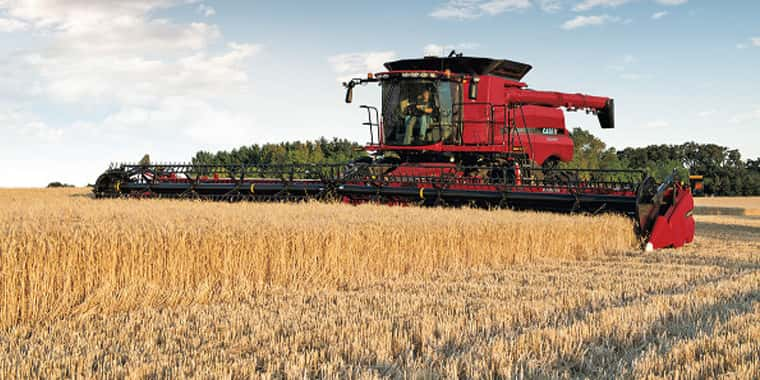by Emily Unglesbee, DTN Staff Reporter
LAWRENCE, Kan. (DTN) — It was a season of low expectations for winter wheat growers in the Southern Plains this summer.
“You know you have a tough year when farmers are just tickled pink that they're getting 40 bushel (per acre) wheat,” Kansas State wheat specialist Jim Shroyer told DTN. “That's just barely paying the rent!”
As the wheat harvest trickles to an end in the Southern Plains, growers and elevators report decent protein, but dropping test weights, below-average harvests, and a broad spectrum of yields.
“The two key words this year are variable yields,” Shroyer said. “That sums it up. You can talk to one farmer who gets anywhere from zero to 10-bushel yields, and down the road, his neighbor is cutting 50- to 60-bushel yields.”
Oklahoma finished bringing in wheat the first week of July, and Kansas will follow shortly, with only 10{ba1edae1e6da4446a8482f505d60d3b8e379ff6dedafe596d9ba4611a4e33a48} remaining as of July 14. Overall, the national winter wheat harvest was 69{ba1edae1e6da4446a8482f505d60d3b8e379ff6dedafe596d9ba4611a4e33a48} completed as of Sunday, July 13.
After a bitterly cold winter and continued drought in much of Kansas, Oklahoma, and Texas, USDA has steadily dropped its winter wheat production estimates for much of the Southern Plains each month.
The most recent reports pegged Oklahoma's winter wheat production at 51 million bushels (mb), roughly half of last year's harvest. Kansas' predicted wheat production dropped to 235.2 mb, which, if realized, would be the state's smallest harvest since 1989. Overall, USDA expects only 1.367 mb of winter wheat this year, down from 1.577 mb last year.
SMALL HARVEST AND FALLING QUALITY
Business was slow for most Kansas grain elevators this July. “We usually bring in 4 to 5 million (bushels of wheat); this year we brought in 1.5 million,” said Dan Cashier, manager of Anthony Cooperative in the south-central town of Anthony, Kan. “I heard yields ranging from zero to 30 bushels.”
In southwestern Kansas, one elevator manager greeted just over half of the normal wheat harvest with enthusiasm.
“I am just tickled because we didn't think we were going to get that,” said Bill Maskus, grain division manager for Pride Ag Resources in Dodge City, Kan. “When we went into harvest, I was saying 40{ba1edae1e6da4446a8482f505d60d3b8e379ff6dedafe596d9ba4611a4e33a48}, and there was a lot of talk that we might not even get that.”
After four long years of drought, a “normal harvest” can be hard to define, said Jeff Cotten, the site manager of AgCo Corporation in Hoisington, Kan. “It's varied so much the last five years that I don't even know what's normal anymore,” he told DTN. “I've heard anything from 8 (bushels per acre) to people getting up to 50.”
Down in Oklahoma, growers have finished the worst harvest in 60 to 70 years, said Mark Hodges, executive director of Plains Grains Inc. in Stillwater, Okla.
“The high point is we have some high-quality protein,” he said. “Protein in hard red winter wheat … is still averaging around 14{ba1edae1e6da4446a8482f505d60d3b8e379ff6dedafe596d9ba4611a4e33a48}. And we also know from preliminary tests that it bakes very well. But we would expect lower flour extraction than what millers would probably like because of smaller kernels, and the volume is just not there.”
Most Kansas elevators reported average protein levels around 13{ba1edae1e6da4446a8482f505d60d3b8e379ff6dedafe596d9ba4611a4e33a48}, with a few reporting levels as low as 9.5{ba1edae1e6da4446a8482f505d60d3b8e379ff6dedafe596d9ba4611a4e33a48} and as high as 16{ba1edae1e6da4446a8482f505d60d3b8e379ff6dedafe596d9ba4611a4e33a48}.
For the final bushels trickling in, last has also been least, grain elevator managers agreed. The second leg of the harvest in early July brought down the average quality of the crop, after June rains dropped test weights and spurred weed growth.
“The first week of harvest the test weights were good — 60 to 61 pounds — and moisture was a little high but dockage was fairly good,” said Dick Tippin, grain coordinator for Cooperative Grain & Supply in Hillsboro, Kan. “But our dockage has gone up and test weights have gone down after we got heavy rains. Overall, our test weights have averaged 59.5 (pounds) and moisture is 13.5{ba1edae1e6da4446a8482f505d60d3b8e379ff6dedafe596d9ba4611a4e33a48}, but lately we've been getting a lot of 56 to 57 pound test weights.”
Many acres were so overrun by the late-season weeds and heavy rain that they may be lost, said Maskus. “There will be weedy fields and fields and terrace channels sitting in water that may or may not be cut,” he said.
In other parts of the country, rains were more timely for wheat growers. After the wet spring, Illinois farmer Dean Campbell's late-maturing crop made him nervous enough to start cutting wheat on June 21 at more than 20{ba1edae1e6da4446a8482f505d60d3b8e379ff6dedafe596d9ba4611a4e33a48} moisture.
“We were getting anxious to get some wheat out of field so we could plant the double-cropped beans,” the Coulterville, Ill., farmer said. “A year ago, we had finished harvest and planted all our double crop beans by the 20th of June.”
Yet when he finished harvesting on July 4, the benefits of the ample moisture supplies were clear. “We had a record wheat harvest,” Campbell said. “I'm 62 years old and I've never harvested wheat over 100 bushels per acre before or seen wheat that good in southern Illinois. Our 500 acres averaged somewhere in the mid-90s, and our 10-year average is somewhere in the mid-70s. We were just blessed with the right weather and picked the right varieties.”
Even in western Kansas, where the rains came only in time to slow down and complicate the wheat harvest, no one is begrudging the rain clouds.
“We're not complaining about rain, not after the last four years,” Maskus said. “I haven't even heard too much complaining about it from farmers because it has just been so dry.”
© Copyright 2014 DTN/The Progressive Farmer. All rights reserved.
Posted with DTN Permission by Haylie Shipp


